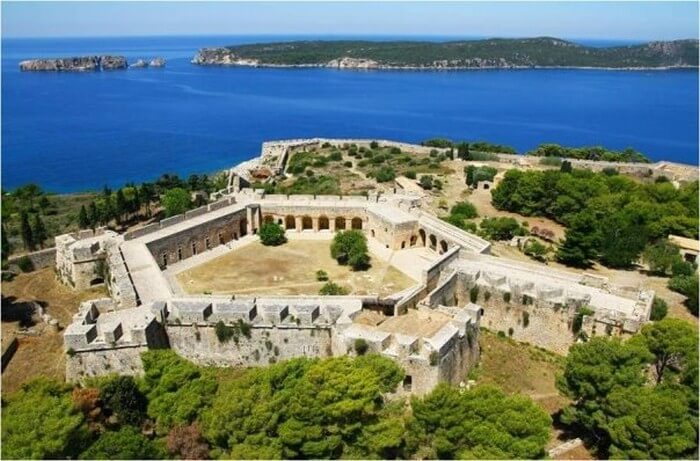
Pylos

Brief Overview
Pylos, historically also known under its Italian name Navarino, is a town and a former municipality in Messenia, Peloponnese, Greece.
Pylos has a long history, being inhabited since Neolithic times. It was a significant kingdom in Mycenean Greece, with remains of the so-called "Palace of Nestor" excavated nearby, named after Nestor, the king of Pylos in Homer's Iliad.
In Classical times, the site was uninhabited, but became the site of the Battle of Pylos in 425 BC, during the Peloponnesian War (in which "The outcome shook the Greek world" - Athens defeated in this Battle, and the next one: Battle of Sphacteria, the Spartans).
Spartans, it had been supposed, would never surrender. Now, with Spartan hostages in their hands, the Athenians issued an ultimatum; any invasion of Attica would lead to the execution of their prisoners. For the first time since the beginning of the war, the Athenians could farm their crops securely.
Pylos is scarcely mentioned thereafter until the 13th century, when it became part of the Frankish Principality of Achaea.

In Detail
This coastal area of the southwest Peloponnese, encompasses the Bay of Navarino. In historical times, Pylos ("the gate") was part of the larger region known as Messenia.
Sheltered by the mile-and-a-half-long island of Sphacteria ("wasp place"), the bay provided an excellent harbor, one of the few of the entire Peloponnese. North and east of the harbor stretched the narrow but fertile coastal plain of western Messenia.
In Greek myth, Pylos was the home of King Nestor, a Greek hero of the Trojan War. Modern archaeology confirms that the Pylos area was a western center of Mycenaean civilization; excavations in the foothills eight miles northeast of the bay have uncovered the foundations of an elaborate palace complex. This palace, built 1400 BCE, was one of the largest Mycenaean citadels, after only Mycenae and Tiryns. Archaeologists have named this fortress the Palace of Nestor.
The palace consisted of three buildings, each two stories in height; their construction slightly resembled Tudor-style half-timbering. Their outer walls were made of limestone; interior elements included wooden columns and wainscoting. The complex was destroyed by fire around 1200 BCE, probably amid the internecine wars that ended Mycenaean society.
Among the items recovered from the ruins by archaeologists are more than 1,200 clay tablets inscribed in Linear b script. A few of these tablets (datable to a spring season just before the palace's destruction) record the inhabitants' keeping of a coastal watch, presumably against enemy naval attack. It was probably just such an attack that demolished the palace.
Despite Pylos's rich natural resources and geographical features, the region remained unoccupied for centuries after the Mycenaean era (although it retained its name). In 425 BCE, during the Peloponnesian War, the Athenian general Demosthenes fortified and garrisoned Pylos's harbor, which lay only 50 miles west of the enemy city of Sparta. The establishment of an Athenian naval base in Messenia was especially crucial to the war effort because the leaders hoped that the region's subjugated population might be incited to rebel against their Spartan overlords.
The threat of an Athenian-inspired Messenian revolt brought Spartan naval and land forces rushing against Pylos. In the ensuing sea battle, the victorious Athenians trapped 420 Spartan hoplites on the island of Sphacteria. The loss of these soldiers - then confined by Athenian naval patrols around the island - was disastrous for Sparta; all the young men belonged to the dwindling Spartan warrior class, and perhaps a third of them were "Spartiates" (Spartiatai), members of the military elite.
At the end of the summer of 425 BCE, Sphacteria was overrun by an Athenian force of 800 hoplites and several thousand light-armed troops, under the leadership of Demosthenes. Of the Spartans, 292 surrendered and survived. The political impetus for this Athenian assault had come from Kleon, who was present at Pylos as an elected Athenian general.
After the battle, the Athenian fort at Pylos remained garrisoned until 409 BCE. Thereafter, the harbor front was uninhabited for the rest of antiquity. The general region is now home to the modern Greek city of Pylos, also called Navarino, located at the south end of Navarino Bay.
Archaeological exploration at Pylos began in 1932 under the American archaeologist Carl Blegen. He discovered the above-mentioned Linear B tablets in the first trench he dug on the site. His work was interrupted by World War II, and he returned in 1952 to work for 12 years. Currently, a project known as PRAP (Pylos Regional Archaeological Project) is focusing on surveying the area around the Palace of Nestor and understanding the settlement patterns of the region during the Bronze Age.
[1]
Official Website and Map
Further Sources
[1] "FoFWeb - From: Encyclopedia of the Ancient Greek World, Revised Edition"
"The Megaron at Pylos: A New Interpretation"
"Encyclopaedia Brittanica"
"Dartmouth University"
Our Mobile Application
Check out Our Mobile Application "Ancient Greece Reloaded"


